|
|
HOOK
 "I apply the eye
ointment &
my Shih Tzu wore an
e-collar for the last
7 days," the couple
said to me. "But the
red spot is still
present. What's the
problem and what is
the solution, Doc?
(SHOW VIDEO OF THIS DOG IF
ANY) "I apply the eye
ointment &
my Shih Tzu wore an
e-collar for the last
7 days," the couple
said to me. "But the
red spot is still
present. What's the
problem and what is
the solution, Doc?
(SHOW VIDEO OF THIS DOG IF
ANY) |
| |
|
|
|
INTRODUCTION |
 "A Be Kind To Pets"
Educational Video "A Be Kind To Pets"
Educational Video
Veterinary Surgery
Comes Alive To Vet
Students & Pet Owners |
| |
| |
|
FLASH BACK |
 |
|
 |
|
|
What
happened to the right
eye of this active
4-year-old male Shih
Tzu?
A red bulging
spot persisted for
over 2 weeks. As there
were financial
budgets over medical
expenses, I prescribed
an eye ointment
and the dog was to
wear an Elizabeth
collar (e-collar) 7
days ago. At this
stage, any advice to
perform eye surgery
would be rejected by
most Singapore dog
owners owing to the
costs and so
conservative treatment
is recommended in this
case.
However, the red
bulging spot persists
and this time, I
advised surgery.
"Your Shih Tzu has a
Descemetocoele," I
sketched an
illustration of the
cross section of the
eyeball and cornea.
(SHOW THIS
ILLUSTRATION of the 4
layers of the cornea -
basement membrane,
Descemet membrane,
stroma and
epithelium).
"His cornea has been seriously injured resulting in a very deep ulcer.
However the cornea has
not ruptured yet or
all liquid from inside
the eyeball will flow
out.
"The pressure of the
liquid inside the
eyeball pushes out the
Descemet membrane and
from your point of
view, you see a red
bulging spot. (SHOW
THIS ILLUSTRATION OF
CROSS SECTION OF THE
EYEBALL WITH BULGING
LUMP). "
"The solution is to
stitch up the eyelids
so that the ulcer can
heal without the dog
rubbing the eye as an
ulcer is very painful.
An exposed ulcer is
irritated by the dust,
breeze and light and
will not heal well if
the dog keeps rubbing
his eye with his paw
or against the wall or
bed."
The surgery requires
anaesthesia and there
is always an
anaesthetic risk of
death on the operating
table. Do you accept
the risk and approve
the surgery?
"How much is the
cost?" the wife asked.
"Around $400 for the
anaesthesia, surgery
and hospitalisation."
"$400 just to stitch
up the eyelids?" the
wife asked.
"The cost involves
more than just
stitching up. There is
the anaesthesia cost,
the time needed to
perform the surgery,
the hospitalisation
for at least 3 days
and the nursing
costs."
|
|
|
 SOLUTION
- SOLUTION
-
Tarsorrhaphy-Nictitans
Membrane Flap |
|
The eye
surgery is called the
Tarsorrhaphy-Nictitans
Membrane Flap. This
involves stitching up
the upper and lower
and 3rd eyelids to cover
the ulcer so that it
can heal without dust
or dryness causing eye
pain.
HOW
THE EYE SURGERY IS
PERFORMED
Elaborating on the
surgery with script
below. |
 |
 |
 |
 |
|
|
Day
1.
After the surgery.
The upper and lower eyelids
and the 3rd eyelid (nictitans
membrane) are stitched up
using 3/0 nylon. This
allows fast
corneal healing take
place. An elizabeth collar is
worn. The dog is
hospitalised for at
least 7 days as the
owners will not
be able to provide
good nursing care. The
dog bites or moves
during eye treatment.. |
Day 3. A
very high standard
of veterinary care of
the eye
by the vet is
required |
Day 3.
Dog has been sedated
and blood clots
removed. Twice daily
inspection & treatment
of the eye is done. |
 |
|
|
|
|
|
Day 6. Stitches loosen.
In most cases,
stitches break down
between 7-10 days, due
to the eyeball
movements. The loose
stitches are removed
on Day 7 in this case. |
 |
 |
|
 |
|
|
Day 7. No more red
bulging spot |
Day 7.
White spot
is a scar plugging the
ulcer. The dog
goes home |
Day 7.
A good
surgical outcome in
this case. The sclera
is not inflamed while
the cornea healing is
excellent. The owners
are happy. E-collar
and eye ointment for
another 30 days. No
complaint >14 days
post surgery.. |
CONCLUSION
No post-op
complaint from the
owner for the past 30
days. The white spot
will remain on the
cornea but has no
significant effect on
the dog's vision. Good
surgical outcomes are
not guaranteed in all
cases of deep corneal
ulcers (deep
ulcerative keratitis).
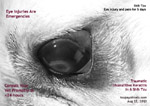 EYE
INJURIES ARE
EMERGENCIES EYE
INJURIES ARE
EMERGENCIES
CONSULT YOUR VET
WITHIN 24 HOURS
OF INJURY TO
SAVE YOUR DOG'S
EYE-SIGHT |
TIPS &
ADVICES
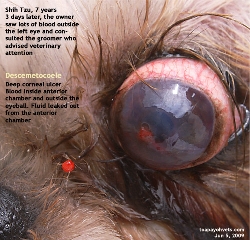 1.
Eye drops & e-collar
as the treatment will
not give good healing
as the dog wants to
rub his itchy and
painful eye all the
time. The
Descemetocoele will
rupture, leaking out
liquid from inside the
eye. Bleeding and
infection will occur
as in one case (image,
left). 1.
Eye drops & e-collar
as the treatment will
not give good healing
as the dog wants to
rub his itchy and
painful eye all the
time. The
Descemetocoele will
rupture, leaking out
liquid from inside the
eye. Bleeding and
infection will occur
as in one case (image,
left).
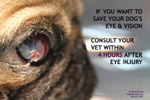 2.
Early treatment before
the cornea ruptures
gives good healing
results but many
owners are reluctant
to pay for the
anaesthestic and
medical costs. So many
vets prescribe eye
drops and e-collars.
This was what I did
for the case study
before the eye surgery
option is accepted by
the owners. 2.
Early treatment before
the cornea ruptures
gives good healing
results but many
owners are reluctant
to pay for the
anaesthestic and
medical costs. So many
vets prescribe eye
drops and e-collars.
This was what I did
for the case study
before the eye surgery
option is accepted by
the owners.
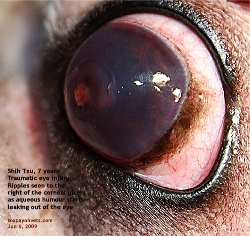 3.
If the owner insists
on bringing the dog
home instead of
hospitalisation, the
surgical outcome is
usually poor (inflamed
sclera and cornea) as
the owner is unable to
apply eye drops and
clean the eye. Some
dogs bite or shift
their head during
nursing or rub their
eye and e-collar
against the wall and
bed when they are at
home. 3.
If the owner insists
on bringing the dog
home instead of
hospitalisation, the
surgical outcome is
usually poor (inflamed
sclera and cornea) as
the owner is unable to
apply eye drops and
clean the eye. Some
dogs bite or shift
their head during
nursing or rub their
eye and e-collar
against the wall and
bed when they are at
home.
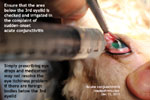 4.
Some vets are against
the 3rd eyelid flap,
saying that the 3rd
eyelid flap obstructs
the application of eye
ointment or drops as
it covers the eyeball.
I make sure that the
eyeball and the inside
of the 3rd eyelid are
well irrigated and
clear of debris before
stitching. 4.
Some vets are against
the 3rd eyelid flap,
saying that the 3rd
eyelid flap obstructs
the application of eye
ointment or drops as
it covers the eyeball.
I make sure that the
eyeball and the inside
of the 3rd eyelid are
well irrigated and
clear of debris before
stitching.
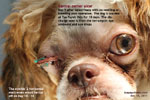 5.
Tarsorrhaphy
(stitching of the
upper and lower
eyelids) may be
another procedure
without the 3rd eyelid
flap. 5.
Tarsorrhaphy
(stitching of the
upper and lower
eyelids) may be
another procedure
without the 3rd eyelid
flap.
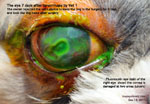 6.
A very high standard
of veterinary nursing
is required. Good
outcomes are usually
due to excellent and
experienced nursing.
The vet must examine
the eye twice a day
and not just leave the
case to the nurses who
may not be experienced
in nursing such cases.
Sedation is required
to clean the eye area
on Day 3. 6.
A very high standard
of veterinary nursing
is required. Good
outcomes are usually
due to excellent and
experienced nursing.
The vet must examine
the eye twice a day
and not just leave the
case to the nurses who
may not be experienced
in nursing such cases.
Sedation is required
to clean the eye area
on Day 3.
7.
Stitches loosen from
Day 6-10 and are
removed. Stitches
can't stay for long
due to the eyeball
movements and tension.
8.
Horizontal mattress
sutures are advised.
Practise placing
horizontal mattress
sutures to close the
skin during the
sterilisation of the
dog and cats and the
vet will have the
necessary experience
to perform
tarsorrhaphy well.
However, most vets
will not use
horizontal mattress
sutures for skin
sutures in
sterilisation.
As in all professions,
practice makes
perfect. If a vet does
hundreds of horizontal
mattress sutures
during sterilisations,
he or she will have
honed his skills which
prepare him or her for
tarsorrhaphy.
Tarsorrhaphy is not a
common surgery for
most practices in
Singapore and much
success depends on
good placing of the
horizontal mattress
sutures.
|
|
P.S.
BE KIND TO PETS
EYE INJURIES ARE
EMERGENCIES
SEEK EARLY VETERINARY
CARE
(show a before
and after tarsorrhaphy
treatment case in a
Pekinese)
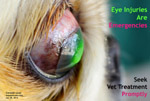 |
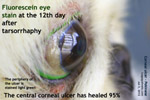 |
BEFORE SURGERY
EXTENSIVE
CORNEAL ULCER |
AFTER EARLY
SURGERY
ULCER HAS HEALED
CLEAR CORNEA
WITH FAINT WHITE
SCAR
|
|
EARLY EYE
SURGERY
(TARSORRHAPHY)
HEALS THE DEEP
CORNEAL ULCER
PREVENTING
RUPTURE & LOSS
OF VISION IN
THIS PEKINESE
|
|
|
|
 CREDITS CREDITS
FOR MORE INFORMATION
judy@toapayohvets.com
+65 9668-6468,
6254-3326
www.toapayohvets.com
(AUDIO-MUSIC) |